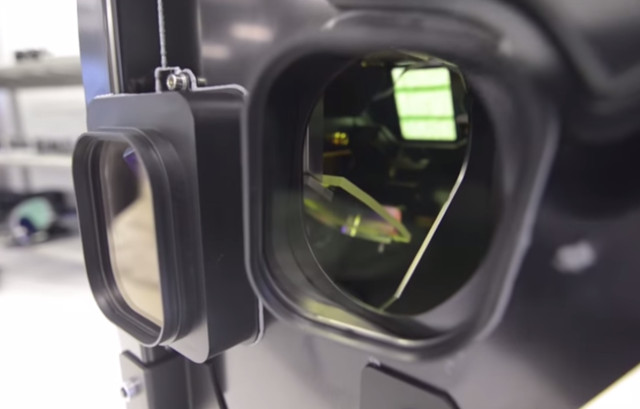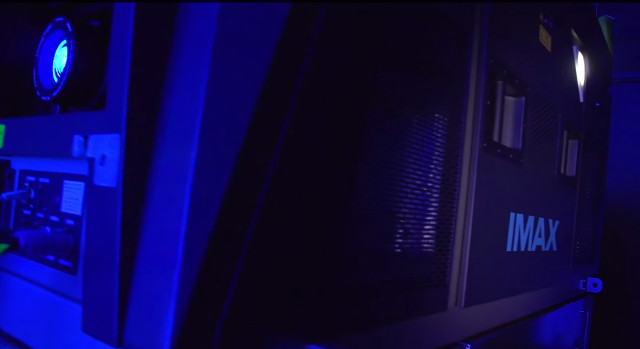I had a chance to visit with Imax in Toronto last Autumn where we discussed the laser projector that was in development. But the firm did not want to reveal very much about the details of the design or performance at the time. Now, there are four systems installed in theaters and in an exclusive interview with Imax CTO Brian Bonnick, we are now able to provide more details on the design.
I have not yet had a chance to see the projector in action. The theaters are located in Toronto, Seattle, Hollywood and Washington DC, but I am told to expect one in New York soon, so I will definitely go and check it out.
The current two-projector Imax laser design is partly based upon IP developed by Kodak for a laser-based projector, probably about 10 years ago. Kodak showed a retrofit laser projector demonstrator in the 2010-2011 timeframe and displayed elements of a ground-up approach to laser projection design that offered even more benefits, as we reported at the time.
But Kodak fell on hard times and Imax eventually licensed the IP and added its own intellectual property. It hired the chief Kodak designer, Barry Silverstein, and, $60M later, it is rolling out projectors.
“After looking at the state of projector technology, we decided the Kodak laser approach was the best way to achieve the highest image quality”, Bonnick told us in the phone interview. “The best image quality then and today is the Imax 1570 film projector and our goal was to develop a projector that could match this image quality. But as we got into the development, we realized by designing the projector from the ground up with a radical new approach, we could even exceed the state of the art”.
Bonnick went on to explain that there are two fundamental flaws with today’s digital projectors – whether they are Xenon- or RGB laser-driven. One is the contrast limitations of the 3-chip DMP prism design which is not that good at eliminating stray light and this reduces contrast. The loss of contrast is compounded by veiling glare in the projection lens and other optics as well.
The second problem is sharpness. As you put higher and high light loads on the DMD chips, they can start to move a little bit due to thermal expansion and contraction. This results in a pixel shift and shows up as slight misalignment of the red, green or blue images on the screen as the three DMDs are now not perfectly aligned. This reduces sharpness.
Fixing the thermal management issue for the DMDs is not really possible with the prism design. The only way to cool the DMDs is from the rear and there is a limited amount of area to extract heat from.
The solution, according to Bonnick, is a new design that does away with the prism and separates the DMDs allowing air cooling of the front and liquid cooling of the back for temperature-stabilized operation under extreme light loads. Bonnick suggested a stressful image is a picture of a bride (white dress) and groom (black Tuxedo). “This causes problems in conventional high-lumen digital cinema projectors but not in the Imax laser projector”.

The design expands the size of the optical engine to about 2 feet (60cm) to allow for the separation of the three DMDs. These are placed in an invar frame, which is highly stable material. All new, flint glass optics and projection lenses were designed and the aperture (f stop) greatly slowed down to improve contrast (I think the base Kodak design was f/8). The free-space light engine is completely sealed as well.
Imax has not revealed the details of the optical path within the engine showing how laser light is directed to the DMDs, where unwanted light is dumped and how the three images are recombined to pass through the projection lens. The lens also has a very high MTF to support sharp 4k images.
Nor do they want to focus on the specification of the projector, preferring instead to focus on the enhanced experience. It is a two-projector design and the current implement is a 6p solution so each projector has a different set of primaries to facilitate spectral 3D. But the 6 primaries could also be implemented in a single projector, noted Bonnick. They can also show 2D content, of course.

While Bonnick did not want to provide much in the way of specifications, he did offer some tidbits. As expected, the system is extremely close to delivering the full Rec. 2020 color gamut, as other laser projectors do. Lumen output is not specified but Imax retimes or color grades all content to 22 fL and they have a rigorous daily calibration procedure using a camera to ensure the projector is operating at this level consistently.
As for contrast, Bonnick suggested that a typical 4k Xenon-based DLP cinema projector has inter-frame (ANSI) contrast of around 1800:1 at best, with the RGB laser versions still very close to this level. A 2k Xenon projector comes in at around 2100:1, while the Imax Xenon digital projector is in the 2600:1 range. The benchmark film-based Imax 1570 projector has between 4500 and 5000:1 contrast. “The Imax laser projector is multiples higher than this”, said Bonnick. “We are essentially at the contrast limit of the DMD now”.
This essentially makes the projector a high dynamic range solution, but as RealD has pointed out in their analysis of theater contrast (Are 1M:1 HDR Theatrical Projectors Really Needed?), it is often the exit lights that dominate the ultimate contrast that viewers experience.
The dual-laser projector solution is designed for screens of 80 feet (25m) and higher and can project in a variety of aspect ratios including 1.43:1, 1.90:1 and 2.39:1. But Bonnick noted that they are now evaluating how to move the technology into a single projector solution focused on the commercial theatrical space.
The improvements in the image quality are hard to put numbers on with current measurement tools, and in fact, is something that the industry may need to consider addressing. Besides the projection technology, Bonnick says it is a whole lot of other little things like the DMR pre-processing they do to clean up images, attention to the curved white screen material, having a very high bandwidth processing chain, the complete monitoring of operating conditions to ensure optimal performance levels and the immersive sound that delivers the experience. Imax is now moving from a 6-channel solution to a 12-channel immersive solution for audio.
The only aspect the company still thinks needs a little work are the 3D glasses which can have some back reflections. Nevertheless, I can’t wait to experience it. (CC)

